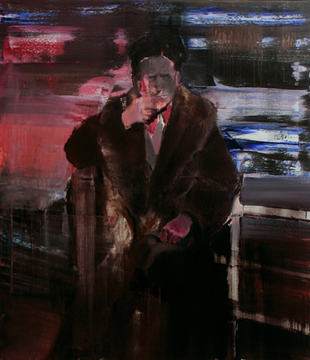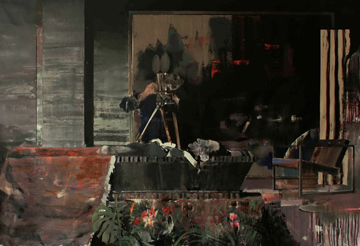
Adrian Ghenie, "Duchamp" (2009)
The problem with writing about contemporary painting is that it ends up being an excuse for a riffle through the thesaurus for the most headily baroque terms to describe the look of paint on canvas. This isn’t a problem when writers write about old paintings, because they tend not to focus on the physical presence of the work, instead treating a painting as a sort of rebus to be decoded and tacked on to a pre-existing idea. Renaissance art historians tend to look through, not at, the paintings in question. Contemporary painting has a hard time because decoding content isn’t what you’re supposed to do; you’re supposed to focus only on the physicality of the thing in front of you: at, not through. The language of at is evasive and slippery and is simply beyond the limits of the technical vocabulary of orthodox contemporary artspeak, like a caveman trying to describe the Internet. Hence the preponderance of purple prose in exhibition catalogues and press releases, laden down with nightmarish adjectival pile-ups more akin to lip-smacking restaurant reviews than anything to do with art.
Adrian Ghenie’s current show at Haunch of Venison on London presents the writer on contemporary painting with what looks like an easy premise: recognizable representational content. His suite of oil paintings collectively titled (like a Cure B-side), Darkness for an Hour, at first look visually pleasing in a loose-and-tight kind of way—neither too finicky and faux-outsiderish, nor too slappy and faux-hamfisted to put off a contemporary art cynic. Ghenie lays on the paint with just the right amount of visual splashiness to look modern and self-aware, while retaining a finessed draftsmanship in the rendering of figures which looks like an appeal to old-timey painterly virtues. To come away from the show feeling as though you’d just wandered through a needy MFA graduate resume (look! I can do abstract painting! Wait: do you like pictures of people? How about BOTH?), which I nearly did, would be understandable but unfair, because of something very rarely discussed or even considered worthy of discussion in contemporary artspeak: content.
Ghenie’s quotations of earlier paintings are there—photo-sourced multi-figure compositions recall both Michael Andrews and Larry Rivers, with areas of squeegeed abstraction out of Richter—but I suspect the references are lightly held, a resonant means of conveyance rather than allusive game playing. These are communicative, gregarious paintings that are emphatically narrative, not obliquely referential. If the heart sinks a bit at his employment of modernist art icons as protagonists (given the contemporary orthodoxy of sneering at modernism), his teasing out of mordant narratives replays well-trodden art historical episodes with a melancholy wit that’s both accessible and alien.
In his painting Duchamp (2009), everyone’s favorite conceptual art behemoth sits swamped in his fur coat, hat in hand against what looks like a railing as a broiling sea churns beyond. While the source image must have been a photograph, it’s not part of the standard repertoire of Duchampian portraiture. The wry smile and supercilious air have been replaced by a creased brow and pensive hand on the chin. His instantly recognizable face is lost in a wash of smears, like a photograph seen through running water, and Ghenie stages a battle of there and not-there, description faltering at the verge of readability. This is the artist in exile, carried across the Atlantic to lasting adoration yet strangely lost, anxious, and almost literally disembodied. In another painting, Urinal, Duchamp’s 1917 Fountain (the urinal on a pedestal) is inspected by a frock-coated officer in a gas mask in a low-lit storeroom. The title’s performance of a reverse magic spell on the found object tradition gives voice to the conceptual art elephant in the room: a urinal? As art? Why did we ever think that? It looks weird and sad, like something out of a time capsule you buried in the past and now can’t remember why.

Adrian Ghenie, "Duchamp's Funeral II" (2009)
Dada appears again as a reference point in Ghenie’s Dada is Dead, which restages the famous photograph of the 1920 International Dada Exhibition, with John Heartfield’s Prussian Archangel (a pig-faced soldier mannequin) bumping along the ceiling and (anachronistically) a Malevich black cross hanging on the wall, each a component of a secular iconography dependent upon the ghosts of art past. Angels and crosses allude to a secularized transfiguration absolutely at the core of Dadaist found object principles, but in Ghenie’s muscular assertion of the primacy of paint, how archaic that religion looks now. A slash of light illuminates a wolf stalking the abandoned gallery, frozen mid-prowl, come to pick the bones clean. The painting has a lovely reflexive weirdness. How strange that Dada is dead, how strange it ever lived, and how strange and surprising that it should be painting that performs the eulogy.
Death and demise overshadow Ghenie’s work. Two paintings depict Duchamp lying in vampiric state: one surrounded by Diana-style cascades of wreaths and bouquets in an otherwise empty space, the other in a modernist apartment complete with Mies chair and movie camera. The paint is applied ecstatically, drooling down the canvas and jumping about in big Ab Ex swathes in somber dark reds and pale grays. On the one hand, it’s an assertion of the undead art of painting itself, perpetually self-vivifying and vital; on the other, its allusiveness is a token of historical distance, of the lost world of the past. Ghenie’s paintings, like Hollywood zombies, are full of an animation that emphasizes death, images jerked alive by jolts of paint, but strange and unsettling and absent nonetheless.



